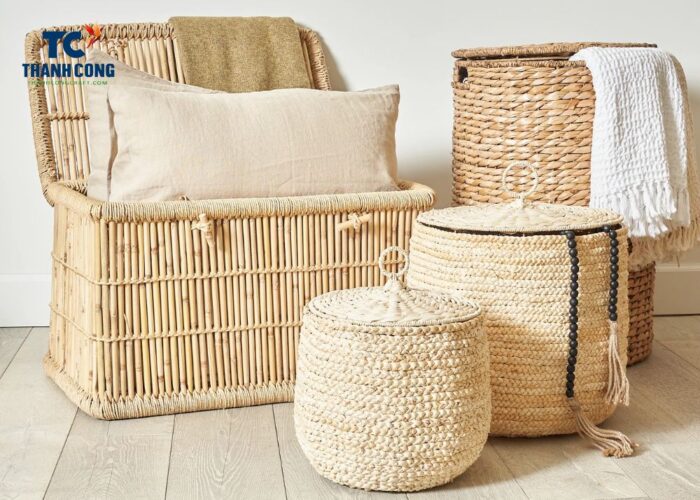-
09-19-2023, 08:13 AM #1Silver member

- Ngày tham gia
- Jul 2023
- Bài viết
- 176
Are seagrass and rattan the same? What is the difference between seagrass and rattan?
Are seagrass and rattan the same?
Are seagrass and rattan the same? No, seagrass and rattan are not the same; they are two different natural materials with distinct properties and uses.
Seagrass:- Seagrass is a type of grass that grows in brackish water environments, primarily in coastal areas and shallow waters.
- It is characterized by long, slender, grass-like leaves that are submerged in water.
- Seagrass is typically harvested, dried, and woven to create various products, such as baskets, mats, and furniture.
- It is known for its durability and natural, rustic appearance, making it a popular choice for coastal and beach-themed decor.
Rattan:- Rattan is a type of palm plant that grows as a vine in tropical regions, particularly in Southeast Asia.
- It has a solid stem that can be harvested, processed, and used for various purposes, including furniture and basketry.
- Rattan is known for its flexibility, making it ideal for weaving and creating intricate designs in furniture and other items.
- It can be stained or painted to achieve different finishes and styles.
In summary, while both seagrass and rattan are used in crafting furniture and woven items, they come from different plant sources and have distinct characteristics. Seagrass primarily grows underwater and is known for its durability and coastal aesthetic, while rattan is a tropical plant vine known for its flexibility and use in furniture and basket making.

Difference between seagrass and rattan?
Difference between seagrass and rattan: Seagrass and rattan are both natural materials used in various applications, but they come from different sources and have distinct characteristics:
Source:- Seagrass: Seagrass is a type of marine plant that grows underwater in coastal areas. It is commonly found in shallow, brackish waters and estuaries.
- Rattan: Rattan is a climbing vine-like palm that grows in tropical rainforests and other warm, humid environments. It is a type of plant that has a solid stem, which is typically used in furniture making.
Appearance:- Seagrass: Seagrass is typically characterized by its long, narrow leaves with a grassy texture. It has a natural, earthy color that ranges from greenish-brown to pale yellow.
- Rattan: Rattan stems are slender and flexible, with a glossy surface. They have a woody appearance and are usually light to medium brown in color.
Use:- Seagrass: Seagrass is often used for weaving and making products like baskets, mats, rugs, and furniture. It is known for its durability and natural texture, making it a popular choice for home decor and furnishings.
- Rattan: Rattan is primarily used for making furniture, including chairs, tables, and cabinets. Its flexibility and strength make it a versatile material for crafting various types of furniture pieces.
Durability:- Seagrass: Seagrass is durable and can withstand moisture well, making it suitable for both indoor and outdoor use. However, it can degrade over time when exposed to excessive moisture or sunlight.
- Rattan: Rattan is also durable and resilient, but it is more susceptible to damage from moisture and sunlight. Proper maintenance is important to ensure its longevity.
Environmental Considerations:- Seagrass: Harvesting seagrass can have environmental impacts, as it plays a crucial role in coastal ecosystems, providing habitat and reducing coastal erosion. Sustainable harvesting practices are important to minimize ecological damage.
- Rattan: Rattan harvesting can be more sustainable if managed properly. Sustainable rattan cultivation and harvesting practices can help reduce the negative environmental impact.
In summary, seagrass vs rattan are natural materials with different sources and appearances, making them suitable for various applications. Seagrass is often used for weaving and home decor, while rattan is primarily used in furniture making.
Both materials have their unique characteristics and considerations when it comes to durability and environmental impact.Chủ đề cùng chuyên mục :
- Illuminate Your Space with Elegance: The Rattan Pagoda Lantern
- Keep Your Feline Friend Entertained with a Wicker Ball Cat Toy
- Create Endless Playtime Memories with the Rattan Doll Crib
- How to decorate a basket with ribbon?
- Organize with Style: The Wicker Toy Chest for Tidy and Charming Play Spaces
- Create a Cozy Retreat for Your Bunny with a Seagrass Rabbit Hideaway
- Wicker Bedside Cabinet: Add Natural Elegance to Your Bedroom Décor
- Bàn ủi Tefal Pure Pop DT2020E1 nhỏ gọn, dễ dàng mang theo
- DIY Guide to Making a Spring Grapevine Wreath
- Cổng tự động đảm bảo an toàn và thuận tiện cho người đi bộ
Có thể bạn quan tâm :
-
What is Rattan Made of? Why is rattan so expensive?
Bởi Thanhcongcraft trong diễn đàn Nội Ngoại ThấtTrả lời: 0Bài viết cuối: 09-12-2023, 07:42 AM -
PE Rattan vs Natural Rattan. Does rattan attract bugs?
Bởi Thanhcongcraft trong diễn đàn Nội Ngoại ThấtTrả lời: 0Bài viết cuối: 09-08-2023, 07:43 AM -
Coastal Elegance: Woven Seagrass Lampshade
Bởi Thanhcongcraft trong diễn đàn Nội Ngoại ThấtTrả lời: 0Bài viết cuối: 08-31-2023, 06:19 AM -
Is rattan furniture waterproof? What happens if rattan gets wet?
Bởi Thanhcongcraft trong diễn đàn Nội Ngoại ThấtTrả lời: 0Bài viết cuối: 08-26-2023, 02:16 AM -
Large Round Seagrass Basket - advantages, where to buy them?
Bởi Thanhcongcraft trong diễn đàn Nội Ngoại ThấtTrả lời: 0Bài viết cuối: 07-28-2023, 04:02 AM



 Trả lời kèm Trích dẫn
Trả lời kèm Trích dẫn





Thông qua phân tích dữ liệu Google từ 86 nhà nước, mới đây, một công ty tại Anh đã ban bố bảng xếp hạng kích thước "cậu nhỏ" của các nước trên thế giới. Kết quả, hồ hết các nước xếp ở nhóm đầu của...
"Cậu nhỏ" của bạn trai Việt thuộc...